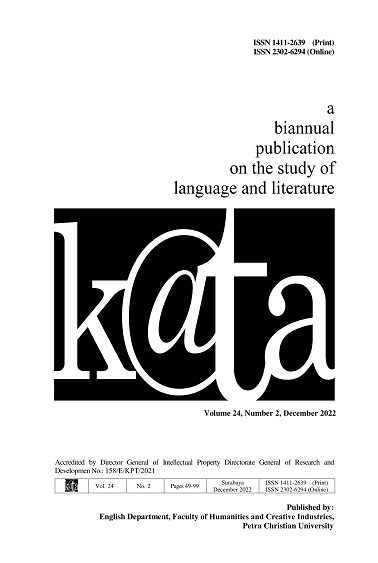A Polyphonic Study of E.M. Forsters A Passage to India and George Orwell’s Burmese Days
DOI:
https://doi.org/10.9744/kata.24.2.61-69Keywords:
Burmese Days, A Passage to India, Bakhtin, polyphony, postcolonial literatureAbstract
The purpose of this study is to examine the multi-voicedness techniques in E.M. Forster’s A Passage to India and George Orwell’s Burmese Days, in terms of the narrator’s role and the plurality of voices and consciousnesses. This paper used the concept of polyphony which was coined by Bakhtin as a methodology in analyzing and examining the aforesaid novels. The results of this study showed that; First, both novels used the omniscient narrator as a narrative technique, since the voice of the author was evident on more than one occasion. Moreover, there was an influence by the omniscient narrator on the reader, which might be considered significant on more than one occasion, in controlling and manipulating his decisions and views in A Passage to India, while the influence was minuscule in Burmese Days. Second, this paper proved that the aforesaid novels are polyphonic ones. Finally, both authors gave a considerable margin of freedom for each character to express their ideologies freely.
Downloads
References
Ashcroft, B., Griffiths, G., & Tiffin, H. (2002). The Empire Writes Back: Theory and Practice in Post-Colonial Literatures. Routledge.
Bakhtin, M. M. (1984). Problems of Dostoevsky’s Poetics (C. Emerson (ed.); 8th ed.). University of Minnesota Press.
Forster, E. M. (1984). A Passage to India. Harcourt Brace Jovanovich.
Genette, G. (1980). Narrative Discourse: An Essay in Method (J. E. Lewin & J. Culler (eds.)). Cornell University Press.
Lodge, D. (1990). After Bakhtin: Essays on Fiction and Criticism. Routledge.
Lothe, J. (2005). Narrative in Fiction and Film: An Introduction. Oxford University Press.
Malcuzynski, M.-P. (1984). Polyphonic Theory and Contemporary Literary Practices. Studies in 20th & 21st Century Literature, 9(1), 75–87.
Matz, J. (2004). The Modern Novel: A Short Introduction. Wiley-Blackwell.
Melia, P. (2015). Imperial Orwell. Atlantis, 37(2), 11–25.
Messenger, N. (1999). A Passage to India, E.M. Forster. Longman.
Morson, G. S., & Emerson, C. (1990). Mikhail Bakhtin: Creation of a Prosaics. Stanford University Press.
Nafi, J. S. I. (2016). Skepticism and Doubt: A Study of Interpersonal Relationships in E.M. Forster’s A Passage to India. European Journal of English Language and Literature Studies, 4(1), 15–27.
Nayar, P. K. (2015). Postcolonial Studies: An Anthology. John Wiley & Sons.
Olson, B. K. (1997). Authorial Divinity in the Twentieth Century: Omniscient Narration in Woolf, Hemingway, and Others. Bucknell University Press.
Orwell, G. (1974). Burmese Days (First Edit). Mariner Books.
Spear, H. D. (1986). A Passage to India by E. M. Forster. Macmillan Education UK.
Tymieniecka, A.-T. (1997). The Reincarnating Mind, or the Ontopoietic Outburst in Creative Virtualities: Harmonisations and Attunement in Cognition, the Fine Arts, Literature Phenomenology of Life and the Human Creative Condition. Springer.
Vice, S. (1998). Introducing Bakhtin. Manchester University Press.
Zylko, B. (2002). Bakhtin & His Intellectual Ambience. Wydawnictwo Uniwersytetu Gdańskiego.
Downloads
Published
How to Cite
Issue
Section
License
![]() This work is licensed under a Creative Commons Attribution License
This work is licensed under a Creative Commons Attribution License



.png)
.png)

















